By Garrett Nada and Alex Yacoubian
As an oil-hungry island nation, Japan’s position on Iran has been fraught with inherent tensions. It has had to balance an existential thirst for oil—to fuel industries, cars and homes—against a moral abhorrence of nuclear weapons, especially as the only country devastated by the world’s deadliest bombs in World War II. Iran has been the nexus of those top priorities—and policy challenges. In an attempt to resolve differences, President Hassan Rouhani traveled to Japan in late December 2019; it was the first visit by an Iranian president in 19 years.
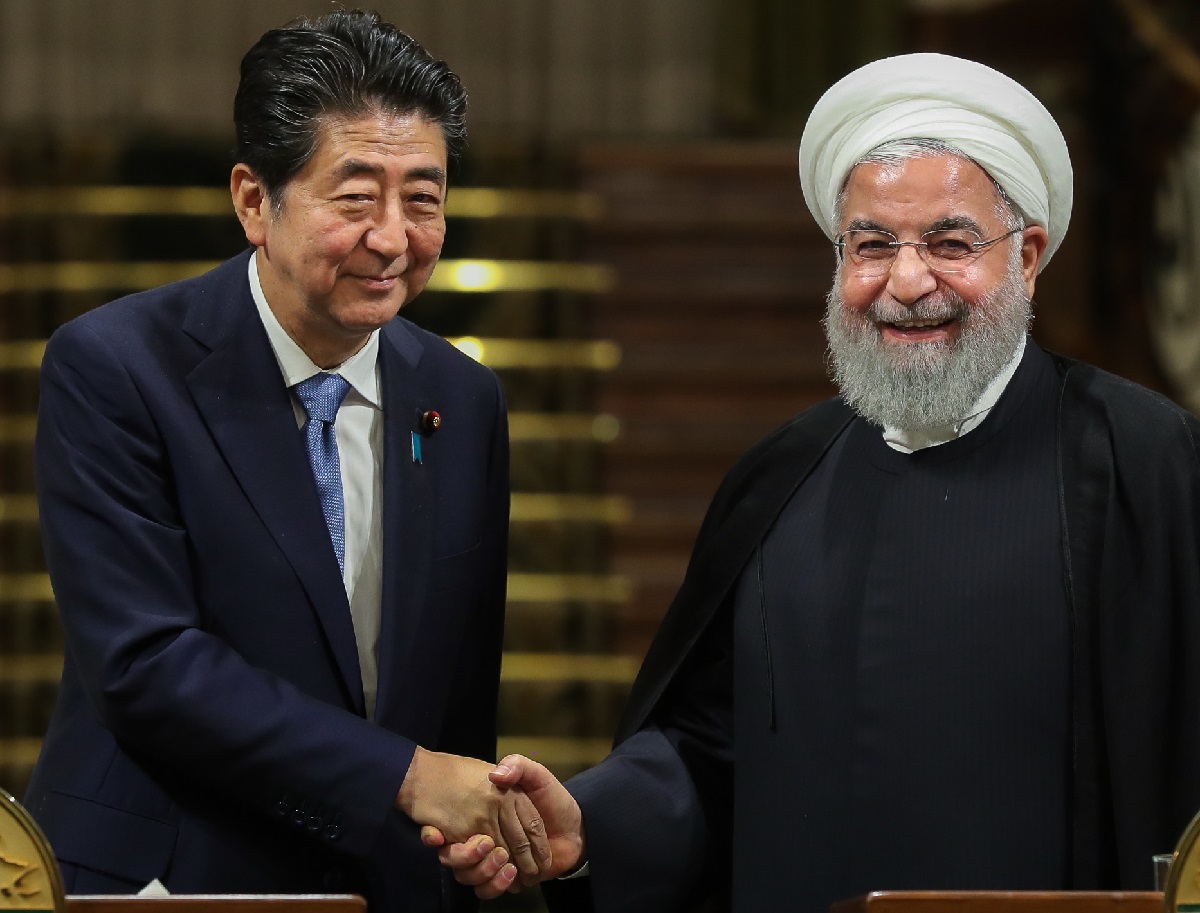
Japan, a heavily industrialized nation, has long been dependent on imported oil. For decades, it has bought some 90 percent of its fuel from the Middle East. Before the 1979 revolution, Iran was one of Japan’s top two sources of oil. Afterwards, Iran was still among Japan’s top four sources of oil for more than three decades. The Fukushima nuclear disaster in 2011 increased Japan’s need for oil and natural gas as alternative fuel. Before the Fukushima crisis, 54 nuclear reactors provided about 30 percent of Japan’s electricity needs. As of September 2019, all but nine nuclear plants remained shut due to safety concerns and public pressure.
Japan has also long been deeply opposed to nuclear proliferation. It has joined key international efforts to prevent Iran from getting a bomb. Between 2006 and 2016, Tokyo fully supported the four U.N. sanctions resolutions designed to prevent Iran from developing the world’s deadliest weapon. It also complied with U.S. sanctions reimposed by the Trump administration in November 2018, which sought to eliminate all Iran’s oil exports.
Japan intends to play a proactive role in solving the nuclear dispute because it “best understands the tragedy of the use of nuclear weapons and shoulders the responsibility to realize a world free of nuclear weapons,” according to its 2013 national security strategy.
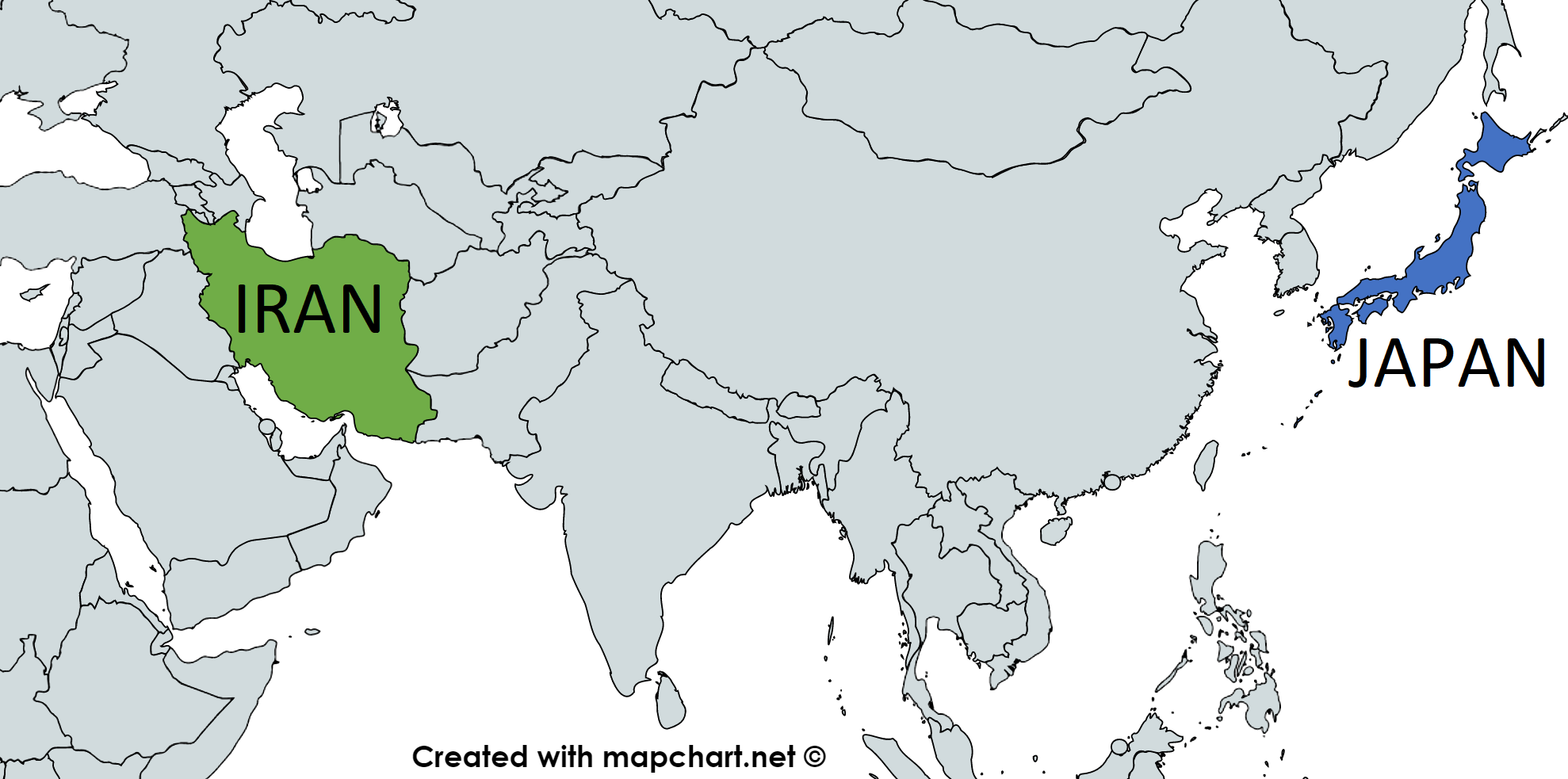
Historic Ties
Japan has had formal diplomatic ties with Iran since 1929. Relations have been strong under both the Pahlavi dynasty and the Islamic Republic. Since the 1979 revolution, Japan has occasionally been a conduit for sensitive messages between Iran and Western nations.
Japan and Iran share two cultural traits that provide common bonds. Both countries emerged from ancient civilizations; both believe their history give them special standing in the world. “Iran is a country with a rich history” that Japan highly respects, Japanese Foreign Minister Fumio Kishida told Zarif during his November 2013 visit to Tehran. The two countries also share the Eastern concepts of respect and “face” as pivotal to diplomacy, politics and even trade.
Iran and Japan share horrific experiences with weapons of mass destruction. Two of Japan’s major cities, Nagasaki and Hiroshima, were the first and only targets of atomic weapons dropped by the United States during World War II. Decades after the 1945 bombing, survivors exposed to low doses of radiation showed a high risk for cancers. Iran suffered more than 50,000 casualties from Iraq’s repeated use of chemical weapons during their eight-year war in the 1980s, according to a 1991 CIA report. Decades later, respiratory diseases and other health issues were still killing Iranian veterans and civilians due to low-dose exposure. “Iran and Japan are two countries that have suffered greatly from weapons of mass destruction,” Rouhani said in a 2013 meeting with Masahiko Komura, the Japanese special envoy.
But relations have also carried a price. Tokyo cannot afford to get too close to Tehran because of its close relationship with Washington, which has far greater importance politically, economically and for security. In 2019, the United States was Japan’s second-largest trading partner, and Japan still relied on the U.S. military for its defense.
Economic Ties
In the past, Japan had occasionally defied its Western allies to maintain good relations with Iran. Japan was one of the few countries that purchased oil from Iran in 1953, after Prime Minister Mohammad Mossadegh nationalized the oil industry previously owned by the British-owned Anglo-Iranian Oil Company. The United States and Britain were so opposed to Mossadegh that their intelligence services jointly orchestrated a coup to restore the monarchy.
After Iran’s 1979 revolution, Tehran exported its first oil shipments to Japan on March 5—the twelfth anniversary of Mossadegh’s death. By 2003, Tokyo imported 683,000 barrels of oil per day from Iran—or 16 percent of its crude oil imports—a new high in trade since the revolution.
Japan’s total oil imports from Iran then began decreasing due to its own economic problems, including more than a decade of high inflation, between 2003 and 2013, and three recessions after 2008. Oil consumption decreased.
Growing international tensions with Iran over its disputed nuclear program led to other cutbacks. In 2010, Toyota Motor Corporation voluntarily halted car exports to the Islamic Republic, citing the “the international environment.” International sanctions imposed in 2012 also impacted Japan’s oil purchases. Japanese imports from Iran fell 39 percent—from 314,129 barrels per day to 191,032 barrels per day—in 2012. Japan’s oil companies continued to buy Iranian oil, but only with a special exemption from U.S. sanctions. In March 2012, Washington granted waivers to Japan and other countries every six months in exchange for reduction in oil imports from Iran. Over the first 11 months of 2013, oil trade dropped another five percent to 178,139 barrels per day. In 2013, Japan imported less Iranian oil than at any time since 1981, when Iran was embroiled in a war with Iraq.
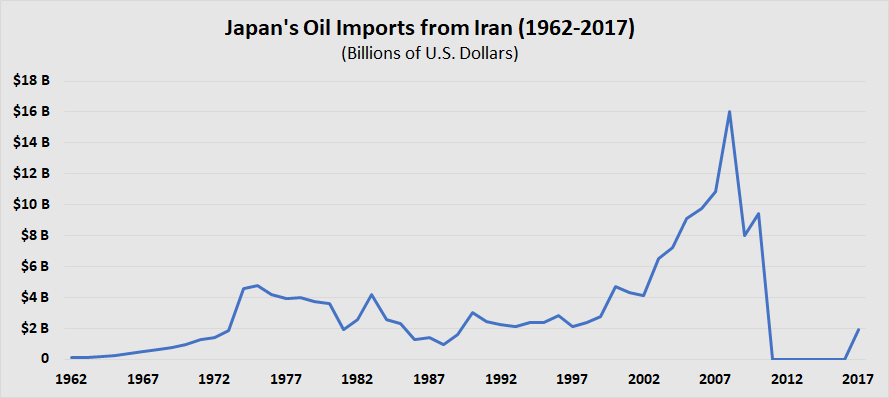
Source: The Observatory of Economic Complexity
The nuclear deal between Iran and six world powers, implemented in 2016, led to the resumption of trade. By June 2016, Japan’s imports of Iranian oil reached 275,000 barrels per day, nearly three times the amount in 2015. Japanese companies, such as Mitsubishi Corp. and Toyota Tsusho, resumed business with Iran after internationally accepted insurance coverage became available again. In 2016, Japanese exports to Iran increased from $282 million in 2015 to $559 million, according to the Observatory of Economic Complexity.
In 2017, Japan-Iran trade totaled about $4.05 billion, according to the Observatory of Economic Complexity. Japan imported $3.23 billion worth of goods from Iran; 98 percent was crude oil. In turn, Japan exported to Iran $851 million of goods, mainly vehicles, machinery, metals, chemicals, and non-metallic minerals.
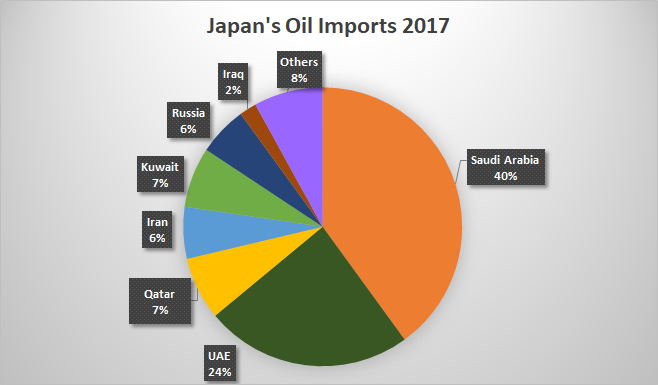
Source: The Observatory of Economic Complexity
The Trump administration’s decision to reimpose sanctions on Tehran in November 2018 had a significant impact on Iranian oil sales to Japan. Japan's imports of Iranian crude decreased by 33 percent between September 2018 and March 2019 -- from 129,300 bpd to 86,430 bpd. In March 2019, Japanese refineries eventually halted all Iranian oil imports. With temporary sanctions waivers due to expire in May 2019, Japanese companies feared financial penalties for violating U.S. sanctions.
But Tehran and Tokyo have vowed to maintain ties. "Despite the US pressures and sanctions, the Japanese government and companies continue to maintain relations with Iran and they will stay in Iran, because Japanese traders and officials trust in the future of Iran," Mitsuo Saito, Japan’s ambassador to Iran, said in October 2018.
Japanese companies have been risk averse because they could face sanctions just for doing business with Iran. After the reimposition of U.S. sanctions in November 2018, Japanese companies halted all Iranian oil imports and suspended contracts on Iran’s domestic oil and gas industry. The companies feared financial penalties for violations of U.S. sanctions.
But private Japanese companies--particularly auto and electronics manufacturers--have also sought business with Iran, given its market of more than 80 million consumers. Japanese products were popular in Iran during the 1980s and early 1990s, but the import of cheaper goods from Korea, and later China, ramped up the competition. Iran has pressed Japan to break with U.S. sanctions and deepen economic ties with the Islamic Republic. “Japan’s interest in continuing to purchase oil from Iran and solving financial issues…can secure the expansion of our relations,” Rouhani told Abe during a June 2019 meeting.
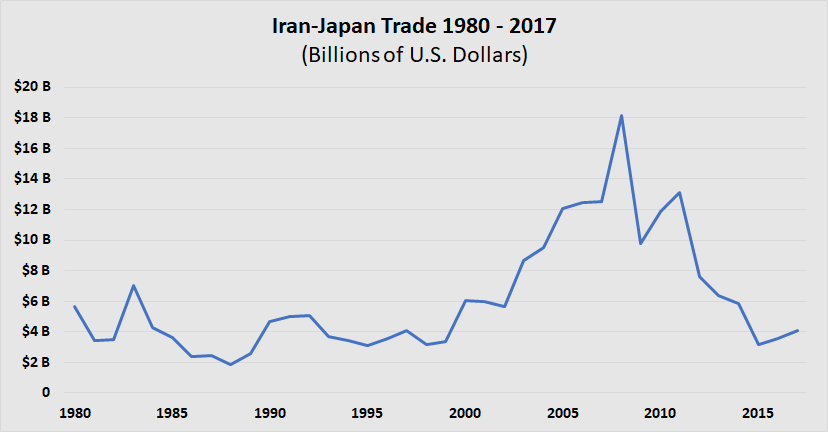
Source: The Observatory of Economic Complexity
Diplomatic Ties
Tokyo has supported several diplomatic efforts to ease tensions between Washington and Tehran. On June 13, 2019, Prime Minister Shinzo Abe delivered a message from President Trump to Supreme Leader Ayatollah Ali Khamenei in Tehran. Abe was the first Japanese prime minister to visit Iran since Takeo Fukuda’s trip in 1978. “At the moment tension is rising. We should do anything we can to prevent an accidental conflict from happening and Iran should play its constructive role,” Abe said. But the Supreme Leader rejected the U.S. overture at diplomacy. “I do not see Trump as worthy of any message exchange, and I do not have any reply for him, now or in future,” Khamenei told Abe. The meeting coincided with attacks on two tankers in the Gulf on June 13; one of the oil tankers, the Kokua Courageous, was owned by a Japanese company. Foreign Minister Zarif called the timing “suspicious.” The United States blamed Iran.
In December 2019, Abe invited Rouhani to discuss bilateral trade as well as tensions between Tehran and Washington. The visit was the first by an Iranian president since Mohammad Khatami’s trip in October 2000.
Japan’s diplomatic outreach reportedly got a green light from President Trump, according to Japanese diplomatic sources. But Iranian officials said that the meeting was unrelated to U.S. negotiations. “The main topic of this visit is to pursue the expansion of bilateral relations and facilitate consultations between the two sides about regional conditions and international issues,” said Iranian Deputy Foreign Minister Abbas Araghchi.
For Iran, the meeting represented an opportunity to find an alternative channel for economic relief after European efforts to circumvent U.S. sanctions largely failed.
Rouhani traveled to Tokyo on December 20 for a day of intense negotiations. He reportedly asked Abe to help maintain the 2015 nuclear deal, which the United States withdrew from in May 2018. “The nuclear deal is an extremely important agreement, and we strongly condemn the U.S. withdrawal, which was one-sided and irrational,” Rouhani said. “We hope that Japan and other countries in the world will make efforts toward maintaining the agreement.” He added that a sustainable deal could be secured through “the logic of negotiation and a win-win prospect.”
Abe expressed concern over rising tensions in the Middle East and urged Iran to comply with the nuclear deal. “I strongly expect that Iran will fully comply with the nuclear agreement and play a constructive role for peace and stability in the region,” he said. Abe reportedly expressed “grave concerns” over Iran’s breaches of the nuclear deal and advised Rouhani to “stop such acts.” But Rouhani contended that Iran’s reduction in commitments were warranted under the agreements’ parameters. Abe also urged Tehran to comply with investigations by the International Atomic Energy Agency (IAEA), the U.N. nuclear watchdog. The IAEA was still awaiting an explanation from Tehran after it found traces of uranium at an undeclared site in early 2019.
Security Concerns
Japanese opposition to Iran’s nuclear program has been complicated by its own unique nuclear interests. Japan is the only non-weapons state under the Non-Proliferation Treaty that has the technology and fuel cycle facilities that could make a bomb; it has reached the so-called “nuclear threshold.” For years, Iranian officials have claimed they are pursuing the “Japan model” of nuclear development.
Tokyo has sought peaceful resolution of the crisis over Iran’s nuclear program for its own energy security. Tehran has occasionally warned that it might block the Strait of Hormuz, an oil transit chokepoint for some 20 percent of global oil exports. The strait’s closure or a military conflict with Iran could endanger Japan’s energy supply. Japan’s 2013 national security strategy prioritized stability in the Middle East as “inseparably linked to the stable supply of energy, and therefore Japan’s very survival and prosperity.” Tehran’s production of a nuclear bomb would be a disheartening defeat for Tokyo.
Iran-Japan Timeline: Diplomatic and Economic Relations
1929
August: Japan opened its first diplomatic mission in Tehran and established diplomatic relations with the palace.
1930s
Bilateral trade between Iran and Japan grew rapidly in the 1930s. In 1939, Japan became Iran’s second largest trading partner, behind Germany, accounting for 10.5 percent of Iran’s total trade.
By 1939, Iranian imports from Japan reached $5 million–19.3 million in yen or 96.6 million in rials-- more than 12 times the 1925 total. Japanese imports from Iran increased to $1.7 million–6.6 million in yen or 32.9 in rials--twice the 1925 total. The textile industry constituted 90 percent of total bilateral trade between 1938 and 1940. Japan relied on Iran for raw cotton, and Iran imported large amounts of Japanese fabrics.
1939
Oct. 18: Iran and Japan signed a Treaty of Amity. Iran had close relations with Nazi Germany and shared an anti-communist policy with Japan. The two countries maintained cordial relations through the early stages of World War II.
1942
April 13: Iran broke off diplomatic relations with Japan after concluding the Tripartite Treaty with the Allied Powers in World War II. The Japanese mission in Iran was shuttered.
1951
September 8: Iran signed the Treaty of San Francisco, officially ending the war with Japan.
1953
February: Japanese refiner, Idemitsu, signed a secret agreement with the National Iranian Oil Company (NIOC) to import crude despite a British embargo on Iran. Idemitsu secretly sent an oil tanker to Abadan, where it loaded 18,468 kiloliters of gasoline and 3,325 kiloliters of crude oil before returning to Japan.
November: Japan and Iran restored diplomatic relations, and the Japanese mission in Tehran was reopened.
June - December: Idemitsu imported 800,000 kiloliters of oil from the NIOC.
1954
Oil trade between Tehran and Tokyo expanded rapidly after Iran nationalized its oil industry in 1951. By 1954, oil exports to Japan accounted for nearly $10.8 million or about 50 percent of total Iranian exports to Japan.
1968
Japan began a period of rapid industrialization and economic growth in the 1960s. It increasingly relied on Iranian oil to supply domestic energy needs. Japan became the largest importer of Iranian petroleum in the late 1960s. In 1968, Iran exported $603.9 million of oil to Japan, which constituted 95.5 percent of Iranian exports to Japan.
1973
Japan began investing heavily in Iran’s domestic oil and gas industry after the oil crisis of 1973. The biggest project was the Iran-Japan Petrochemical Company (IJPC) in April 1973—a $600 million joint venture between the National Petrochemical Company of Iran (NPC) and a consortium of Japanese companies headed by Mitsui and Co.
1974
Japan and Iran signed a travel agreement that allowed Japanese and Iranian citizens to visit travel without visas.
1973-76
More than 100 Japanese companies established offices in Tehran; investments totaled $873 million, or 6.2 billion rials. By 1976, Japanese investments accounted for nearly half of all foreign investments in Iran. By 1976, Iranian oil exports to Japan reached $4.2 billion. Oil accounted for 94.2 percent of total Iranian exports to Japan.
1978
September: Japanese Prime Minister Takeo Fukada visited Iran.
1979 Revolution
1979
February: The Japanese government officially recognized the Islamic Republic of Iran after the revolution.
1980
April: Japan, the largest importer of Iranian crude, agreed to cease all imports from Iran due to the U.S. hostage crisis. In November 1979, Iranian students had seized the U.S. Embassy in Tehran and took 52 Americans hostage.
1981
January: Relations between Iran and Japan normalized after the Algiers Accords ended the U.S. hostage crisis.
1982
May: Japan’s minister of foreign affairs, Yoshio Sakurauchi, said that Tokyo would remain neutral in the Iran-Iraq War (1980-88) and offered to host talks to end the conflict. The war, between two of Japan’s major economic partners in the Middle East, hurt Japanese investments. Tokyo’s efforts to conduct diplomacy and ease the conflict were largely unsuccessful.
1984
Japan remained Iran’s largest trading partner by volume throughout the Iran-Iraq war, but Tokyo’s imports of Iranian oil decreased due to the conflict. In 1984, Iran’s petroleum exports to Japan fell to $2.8 billion, only two-thirds of the 1976 total.
1989
October: Japanese companies withdrew from the IJPC project due to damage to oil infrastructure sustained during the Iran-Iraq war. Tokyo paid a settlement of $945 million, or 130 billion yen
1992
April: An influx of illegal Iranian laborers, who took advantage of Japan’s policy that did not require visas for entry into Japan, created tension between the two countries. Iranian migrants increased by 25 percent from 1990 to 1991. In April 1992, Japan and Iran began requiring visas for entry into both countries.
1994
Iran’s petroleum exports to Japan steadily throughout the late 1980s and early 1990s but still remained below pre-revolutionary levels. In 1994, Iran exported $2.6 billion of petroleum to Japan compared to $2.4 billion in 1991.
2000
October: President Mohammad Khatami visited Japan to discuss deeper economic ties with Tokyo. Khatami's trip was the first visit by an Iranian president to Japan since the 1979 revolution. Iran agreed to give Japanese firms negotiating rights to develop the newly discovered Azadegan oil field in southwestern Iran—the largest oil field discovered in Iran in three decades.
2003
In 2003, trade between post-revolutionary Iran and Japan hit a new high, as Japan imported 683,000 barrels of oil per day from Iran -- or 16 percent of its crude oil imports.
2004
February 19: After four years of negotiations, three Japanese companies--Inpex Corporation, Japan Petroleum Exploration Company and Tomen Corporation--signed a $2 billion contract with Iran to develop the Azadegan oil field. It was one of the biggest foreign investments in Iran since the 1979 revolution. The field was expected to pump 260,000 bpd when completed.
2006
Iran reduced Japan’s stake in the Azadegan project from 75 percent to 10 percent in 2006 after Japan’s Inpex had failed to begin work on the field due to fear of U.S. financial penalties. After the Iranian nuclear issue was referred to the United Nations in 2006, Japanese companies grew more hesitant to invest in Iranian projects.
2008
Japanese Prime Minister Yasuo Fukuda and Iranian President Mahmoud Ahmadinejad met in Rome during the World Food Summit to discuss nuclear issues. It was the first meeting between leaders of the two countries in eight years. Fukuda reportedly pressed Iran to comply with U.N. Security Council Resolutions and suspend ongoing enrichment activities. Iran’s refusal to abide by international norms led Tokyo to decrease trade relations with Tehran.
2010
Sept. 3: Under pressure from the United States, Japan imposed sanctions on Iranian banks and banned investment in new Iranian energy projects. “We took those steps as they are necessary to push for nuclear non-proliferation and prevent its nuclear development,” Chief Cabinet Secretary Yoshito Sengoku said. “We have traditionally close relations with Iran and from that standpoint, we will patiently encourage the country towards a peaceful and diplomatic solution.”
Oct. 15: Japan’s Inpex Corporation pulled out of the Azadegan oil field contract.
2012
In 2012, Iranian oil exports to Japan dropped to 191,032 barrels per day due to the U.S. sanctions.
2013
Nov. 11: Japanese Foreign Minister Fumio Kishida held talks with his Iranian counterpart, Mohammad Javad Zarif, in Tehran. Kishida and Zarif issued a joint statement calling for increased bilateral cooperation in trade and regional issues. They emphasized historical ties dating back to trade on the ancient Silk Road. “Japan is an old and traditional partner of Iran in various economic, industrial, and cultural fields, and it is necessary that it would preserve and even strengthen its status in those fields,” Zarif said.
2015
July 14: Iran and six world powers reached a landmark deal in which Iran agreed to curb its nuclear program and provide access to inspectors in exchange for sanctions relief. The agreement, known formally as the Joint Comprehensive Plan of Action (JCPOA), was implemented in January 2016. Japan supported the accord.
2016
Japan’s crude oil imports from Iran rebounded. In June 2016, Japan’s imports of Iranian oil reached 275,000 bpd, nearly three times the amount in 2015. Japanese companies, such as Mitsubishi Corp. and Toyota Tsusho, resumed business with Iran after international insurance coverage became available again. Japanese exports to Iran increased from $282 million in 2015 to $559 million in 2016, according to the Observatory of Economic Complexity.
February: Japan’s Bank for International Cooperation and Nippon Export and Investment Insurance offered Tehran a $10 billion credit line to spur Japanese investment in Iran’s oil and gas industry.
Japanese Foreign Minister Fumio Kishida and Iran’s Minister of Economic Affairs and Finance Ali Tayybnia signed a bilateral investment agreement to provide “financial cooperation” in joint ventures in Iran.
2018
May 8: President Trump announced the U.S. withdrawal from the JCPOA and the reimposition of sanctions on Iran. The other five parties, including Britain, China, France, Germany and Russia –vowed to stick with the accord. Iran vowed to fulfill its obligations if its economic benefits were guaranteed. Japan’s foreign ministry said it regretted the U.S. decision. "We hope that the countries involved will continue to deal with the issue in a constructive manner," said Foreign Minister Taro Kono.
October: Japan’s crude oil imports from Iran dropped significantly as Japanese companies feared U.S. financial penalties. In October 2018, Japan imported only 50,000 bpd from Iran.
Nov. 5: The Trump administration granted temporary waivers to Japan and seven other countries to continue importing Iranian oil at reduced levels for a 180-day period.
2019
March 29: Japanese refineries halted all Iranian oil imports before temporary sanctions waivers were due to expire on May 2. The companies feared financial penalties for violations of U.S. sanctions. Japan imported 15.3 million barrels of Iranian crude from January to March, equivalent to 86,430 barrels per day (bpd). It was a 33 percent decrease from 129,300 bpd imported between January and September 2018, before renewed U.S. sanctions kicked in.
May 15: Foreign Minister Zarif met with Prime Minister Shinzo Abe in Tokyo to discuss growing tension in the Middle East. Iran hoped to deepen economic ties with Japan and other Asian partners to ease the effects of U.S. sanctions.
June 13: Prime Minister Abe met with Supreme Leader Ayatollah Ali Khamenei in Tehran to discuss tensions between Iran and the United States. Abe reportedly delivered a message from President Trump to Khamenei, but the Supreme Leader rejected the diplomatic overture. “I do not see Trump as worthy of any message exchange, and I do not have any reply for him, now or in future,” Khamenei told Abe.
The June 13 meeting coincided with an attack on two tankers—including the Kokua Courageous owned by a Japanese company—in the Gulf. The United States blamed Iran.
You said Mr. @abeshinzo, that Trump has said negotiations with the U.S. would lead to Iran’s progress. By the Grace of God, without negotiations & despite sanctions, we will progress.
— Khamenei.ir (@khamenei_ir) June 13, 2019
Oct. 18: Japan announced it would not join a U.S. maritime coalition to protect merchant shipping in the Persian Gulf. “We won’t join the United States, but will cooperate closely with them,” said Chief Cabinet Secretary Yoshihide Suga. “Self Defense Force assets will ensure the safety of vessels related to Japan.” Tokyo said it would send warships and aircraft to patrol the waters.
Dec. 4: Japan proposed a plan to send around 270 sailors to protect Japanese ships transiting the Persian Gulf. Tokyo would reportedly deploy one escort ship and one patrol aircraft in a one-year mission that could be renewed annually. Japan’s constitution permits only self-defense operations.
Dec. 20: President Rouhani met with Prime Minister Abe in Tokyo to discuss deepening economic ties and tensions over the 2015 nuclear deal. Rouhani reportedly asked Abe to help maintain the 2015 nuclear deal, which the United States withdrew from in May 2018. Rouhani said that a sustainable deal could be secured through “the logic of negotiation and a win-win prospect.” Abe expressed concern over rising tensions in the Middle East and urged Iran to comply with the nuclear deal. He also urged Tehran to comply with investigations by the U.N. nuclear watchdog.
This article included information from an earlier piece by Garrett Nada.
